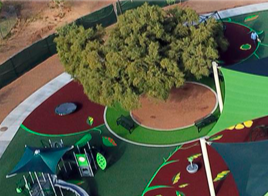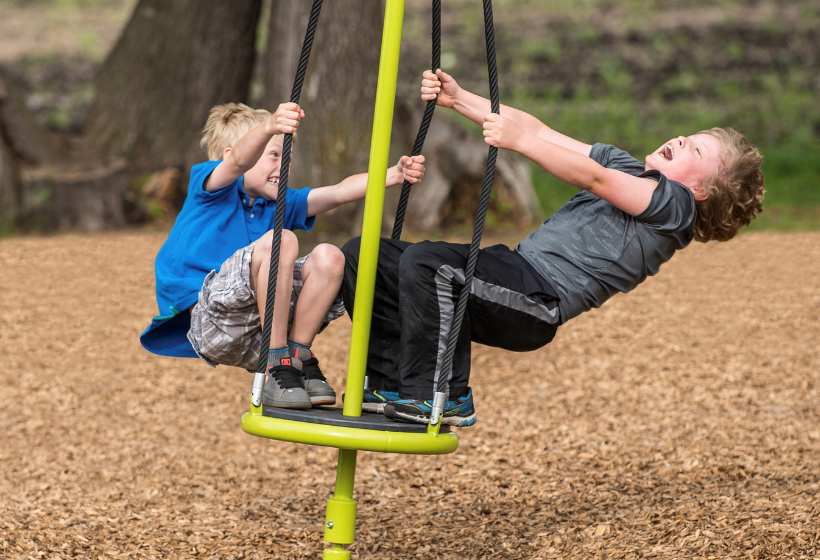Playgrounds are more than just a fun place for kids to spend free time — they are a source for learning and fun. While they are great for outdoor play, local playgrounds are said to benefit child development as well as your community’s overall well-being in a number of different ways.
Playtime is Key for Child Development
The act of playing is how children learn to engage and interact with the world. Play is so important that it has been deemed a birthright for kids. According to the Official Journal of the American Academy of Pediatrics, play “has been recognized by the United Nations High Commissioner for Human Rights as a right of every child.” With that said, it’s crucial that families, teachers and caregivers encourage this fun behavior in children to help benefit their development.
Mental Benefits of Play
Playing in the fresh air can go a long way in reducing stress and increasing attention spans for children. It’s no wonder most schools are required to have recess, which is a regularly scheduled period to get kids playing outdoors.
Recess is said to benefit the mental health of students by improving their memory, attention and concentration. This designated free time outside — oftentimes on a playground — can also help reduce disruptive behavior and keep kids on-task in the classroom.
Emotional Benefits of Play
When kids succeed at taking small, controlled risks outside or on the playground, it can boost their self-confidence. Over time, as they continue to overcome these obstacles on their own, children develop a sense of independence and positive self-image.
Play can also benefit kids who are dealing with trauma. Although young children affected by some form of trauma struggle to experience imagination or adventure, playing can help them cope with their emotions. According to Childhood Education International, kids “find it helpful to reenact their worries in play, as the surprise and fear of the traumatic experience becomes familiar and predictable and, therefore, under their control.” Thus, play is a powerful part of helping children heal from their past or ongoing situations.
Social Benefits of Play
Interacting with peers and adults is a huge part of any child’s development. One of the best ways to encourage social learning is through outdoor play.
On the playground, kids are often faced with moments where they must take turns, share and win or lose a game. It’s a natural space for kids to learn how to work together and build relationships with one another.
Physical Benefits of Play
Outdoor play has a profound effect on a child’s motor skills and overall health. With more space to run around, jump and climb, kids can test their physical abilities and build muscle strength when they play outside. In turn, staying physically active limits a child’s risk of health issues such as obesity and mood disorders.
Playground Activities Target Different Skills
An easy way to facilitate play is by visiting your local playground. Playgrounds are one of the most inexpensive and innovative ways to help kids create and explore a world they can build entirely by themselves. As they play within this world, children start to develop skills that may help them when faced with challenges in the future.
Interestingly, playground equipment and activities are designed to specifically boost child development.
Swinging Helps with Motor Skills
Swings can be found in many parks and playgrounds, and they are ideal for helping children practice balance and use motor skills. A child might use fine motor skills when he or she grips the chain of a swing. These same small muscles in a child’s hand and wrist also help with other small movements such as holding a pencil to write a sentence or draw a picture. Swinging engages gross motor skills, too. Children must pump their legs and remain balanced to move higher in the air.
Climbing Helps Build Body Awareness
Some playground equipment is designed for climbing, which can engage a problem solving skill in children. In order to climb high on anything, a child must have the body awareness to know how to position themselves so they can make it to the top.
Free Play Engages the Imagination
There are hundreds of ways a child can play without an adult ever having to use toys or organize a game. On the playground, kids can use their imagination to invent their own way of playing. Free play allows kids to take limited risks. Overcoming any of these challenges teaches children how to resolve conflict on their own.
Playgrounds Encourage Kids to Get Outdoors
It’s no secret that kids are spending more time in front of screens than they have in the past. Digital technology is on the rise and you can find devices almost everywhere, especially in the home and at schools. As a result, young kids are spending more time indoors. A study found that kids spend twice as long looking at a screen than they do playing outdoors.
In order to combat this extra time inside and behind a screen, some doctors have started prescribing outside as a way to improve the mental health of children. Research shows that spending time outside reduces anxiety and depression symptoms in children ages 7 to 12-years-old. It is also said to help with negative behaviors in youth.
Some studies have even suggested that time spent in natural surroundings can ease ADHD symptoms. Researchers have found that a greater exposure to nature increases attentiveness and creativity.
A thoughtfully designed playground can inspire kids to want to go outside and interact with nature. While some playgrounds may only sit on a small bit of green space, others may be surrounded by trees, grass and possibly running water. No matter the setting, being outside still presents an opportunity for kids to form a relationship with the natural environment.
Research has shown that kids who simply have a greener view from the window, could have better impulse control than ones who are sitting without a view. While it is still important to get kids outside, it’s evident that exposure to green space is beneficial. Having designated time in the outdoors is stimulating for children and encourages them to feed their curiosity about how the world works.
Play Areas Include Kids of All Ages and Abilities
By playing on playgrounds with equipment designed to be accessible for any age or ability, kids get the opportunity to learn about inclusivity early in life. A thoughtfully planned outdoor play area allows kids to play in the same space as others who might have special needs or disabilities.
Playing together in an inclusive environment can help break down barriers and foster friendships among children. At the same time, young kids working on basic motor skills can play alongside kids who are older or more athletically-inclined.
One way playgrounds offer inclusive play is by ensuring safety surfacing is ADA Accessible for children, parents, caregivers and others with disabilities. In order to meet ADA standards, playground surfacing must create a unitary flat surface that allows for the ease of wheelchairs and crutches. At TotTurf, we have an ADA Accessible Playground Surfacing Checklist to help with any planning for playground flooring. Our checklist expands on each type of ADA accessible playground surfacing such as Poured in Place Rubber Surfacing, Synthetic Playground Turf, Bonded Rubber Surfacing and Engineered Wood Fiber Surfacing.
Playgrounds can Positively Impact Communities
Not only are playgrounds a great space for kids to play, but having outdoor recreational areas is also said to have a positive impact on youth with negative behaviors.
According to a study by the International Journal of Environmental Research and Public Health, “playgrounds can provide the opportunity for children to learn social and developmental skills, which may help them function more effectively in groups, and ancillary parent interaction has the potential for community adhesion through shared childcare activities.” In particular, researchers have found that the presence of playground amenities and youth activities reduces the “frequency” of criminal behavior in this age group.
How to Build a Playground Near You
If your community is in need of a fun space for kids to play, there are many organizations that offer funding to help you build a playground. Our partners at Play & Park, have put together a Grant Opportunity Guide to help you on your path to applying for grants on the local or international level.
When you start planning out playground flooring for your new play area, we offer products from Poured Rubber to Engineered Wood Fiber. We promise forthright customer service, credible installation services and dependable maintenance programs. Compare the price of our playground surfacing products using our playground surfacing cost guide.
Interested in getting a quote? Contact us for more information about our playground surfacing options.



